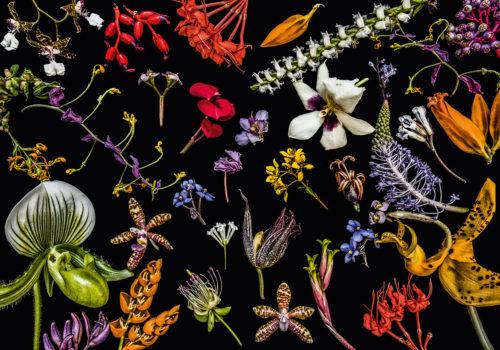Tulips, roses, irises, narcissi, isolated on a black or a white background, the artist based between Berlin and Amsterdam recently presented a selection of his extensive photographic work devoted to flowers at the nüüd galerie that represents him. The work, which spans several years, entitled “Fading Beauty”, captures flowers in bloom until they fade. A journey of delicate portraits in which shapes, hues and textures celebrate the ephemeral nature of existence. This sensitive tribute to the beauty that time irreversibly transforms is reminiscent of the work of Irving Penn, whose interests the Bahamian-born artist seems to share. An encounter.
Noémie de Bellaigue : Can you tell us about the origins of this encyclopedic work devoted to flowers? What were your initial inspiration and your original intention?
Dale Grant : My beginnings photographing flowers was very organic. I always saw the beauty and photographic possibilities of flowers. For example, when I bought flowers at the flower market and brought them home, many times I would take photos of the flowers just to capture their beauty and try to capture what I saw in the flowers.
My career began as a fashion photographer. While I was studying international relations in Paris with the intention to then study law in London I quickly realized it was not meant to be. A friend of mine was a fashion photographer and after assisting him on a fashion shoot one day I knew that I wanted to do the same, so I started accompanying him more often. After many more years as a fashion photographer I fell out of love with the fashion industry. During that time, I was photographing flowers more and more, very much inspired by the beautiful flowers that surrounded me in Amsterdam where I lived back then. Over time I realized that people began to be interested in my floral photography and I made the decision to get out of fashion photography and become a fine art photographer with flowers as my muse.
NB : Shooting at different stages of bloom reveals both the complexity and the particularity of each flower. What did you discover in the course of this work?
DG : I discovered that beauty can be seen in all stages of life. When we buy a bouquet of freshly cut tulips for example, they all look the same. However it is when they all begin to open that we discover that each tulip has its individual characteristics and personality. This is what I love to capture when I photograph flowers.
NB : The pictorial force of ‘Fading Beauty’ is at its most powerful in your flower compositions, which are veritable frescoes… Can you tell us more about the artistic process that led to such refined results?
DG : I realized early on that by isolating flowers against a black backdrop, the vivid colors and shapes of the flowers are more expressive and brought forth, similar to photographing the portrait of a person against a black background. I would bring flowers home, place them in a vase on the table and observe them; when I thought that the moment was perfect for capturing their beauty in all of its glory, I would take the shot. Like the face of a person, I would play with all angles of the flower until I reached the perfect one.
I prefer natural light shot at a low shutter speed which allows me to capture all of the intricate textures, shapes and forms of the flower.
NB : When we look back at your other works, particularly your portraits of artists, a strong allegorical content emerges. In these still lifes, and in the patience you’ve shown in observing them, we can’t help but see a kind of connection with ‘Fading Beauty’; can you tell me more about that?
DG : I am happy that you noticed this. I see flowers as an allegory for life from the moment they begin to open up to the moment the petals begin to dry and fall off from their stems. As with flowers, I seek to find the beauty in the faces of the people who I photograph no matter which stage of life they are going through; I seek to find the beauty in any stage of life. To me, the aging of a flower or a face makes for a different kind of beauty, but beauty nonetheless.
The biggest compliments that I get on my series are from people who would typically throw away their flowers the moment they begin to die; they tell me that my photographs of dying flowers drove them to keep the flowers longer because they can now appreciate the beauty of the aging and eventual disintegration of flowers.
NB : Three photographs of sumptuous dahlias open your monograph ‘Fading Beauty’. They are signed by your mother to whom you pay tribute among others: Doritt Grant, herself a photographer. To what extent does your mother’s practice resonate with yours, and has it influenced your view of flowers and photography more generally?
DG : My mother was a photographer in the Bahamas and I have fond memories of going into her studio as a child and watching her make portraits of people who came to be photographed by her. We kept a box of old photographs at the house and included in this book was a series of dahlia flowers that she shot in 1969. Growing up I was always fascinated by these photos because they were so different from all of her other work. The path that I took into photography with portraiture and floral photography as my main subject was influenced by my mother, subconsciously, I am certain.
Interview par Noémie de Bellaigue
“Dale Grant : Fading Beauty” published by Kerber Verlag.
















